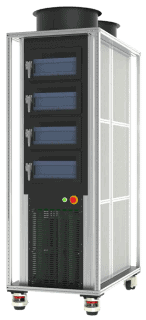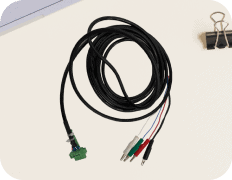Schedules
How to perform DC Internal Resistance measurement with Arbin?
Mechanism explanations: Arbin’s MITS software uses pulse method to calculate IR. In order to achieve better accuracy, the software measures the IR 10 times and takes the average. The pulse looks like the graph bellow: IIR is the amplitude value T2 is the extra control value1 I0 is the offset value IR Calculation Formula: IR […]
Read MoreEnhancing Battery Testing Safety with a Door Switch Interlock System
I. Purpose and Applicability Battery testing—whether for electric vehicles, consumer electronics, or industrial systems—demands strict safety protocols. One often overlooked but critical element in test chamber safety is the door switch interlock system. This simple yet powerful mechanism helps prevent injuries, equipment damage, and test data corruption. In this article, we’ll explore how door switch […]
Read MoreHow to perform Internal Resistance measurement according to IEC 61960 with Arbin?
IR measurement is crucial to have an insight into a battery. There are many way, i.e. many standard to measure battery’s IR. This article will introduce IEC 61960 standard and how to implement it using Arbin’s equipments. IEC 61960 standard for battery IR: In this standard, a discharge pulse of 0.2C is given for 10 […]
Read MoreIntegrated Electrochemical Impedance Spectroscopy (EIS) With Arbin Charge/Discharge Channels
Introduction Electrochemical Impedance Spectroscopy (EIS) is a foundational diagnostic technique for evaluating battery health, internal resistance, degradation mechanisms, and electrochemical behavior over time. However, EIS is traditionally limited by hardware complexity and high per-channel cost, making it difficult to scale across large battery test systems. To address these challenges, Arbin Instruments offers an integrated EIS […]
Read MoreAuxiliary Voltage Measurement
Introduction The Arbin Auxiliary Voltage Input Module enables precise, high-resolution voltage monitoring for battery testing applications that require measurements beyond the standard I/V channels. Typical use cases include monitoring individual cell or module voltages within a larger pack, measuring reference electrodes in three-electrode cells, or comparing BMS data with directly measured values. Each module supports […]
Read MoreConstant-C-rate w.r.t. actual capacity, rather than constant current with Arbin cyclers
As we all know, the batteries’ capacity degrade by cycle of charge and discharge. If we set the charge and discharge current of a fixed value, such as 1A, 2A,… the length of each cycle will gradually decreases, simply because the battery’s capacity decreases: Cycle time = (Charge Capacity + Discharge Capacity)/Current Sometimes users want […]
Read MoreSynchronize different battery charge/discharge channels in one environmental temperature chamber
MTCI Introduction Arbin’s MTCI (Multi-Temperature Chamber Interface) module offers seamless and sophisticated integration with third-party environmental chambers, enabling direct control of temperature and humidity setpoints from within the Arbin test schedule. This streamlined setup allows test engineers to program and adjust environmental conditions alongside electrical cycling parameters, eliminating the need for separate chamber control systems. […]
Read More






















